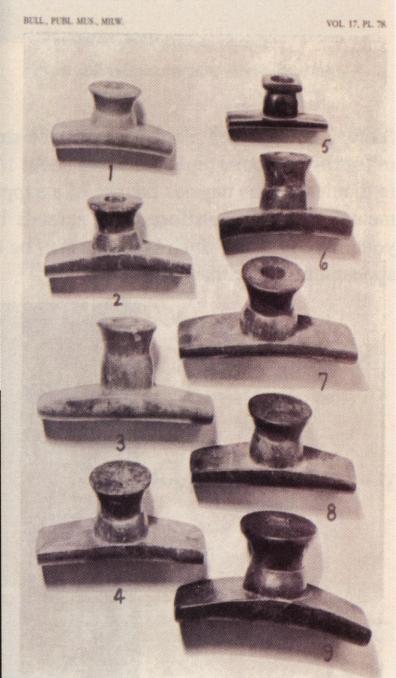The Hopewell Curved-Base Monitor Pipe
Steven R. Cooper, EIC
Originally published in the Central States Archaeological Journal, Vol.57, No.3, pg.144

Above: Hopewell Pipe from Ohio, 4 inches in length. Len and Jamie Weidner Collection, Westerville, Ohio.
Pictured above is a Hopewell Monitor pipe that displays the form common to this style, a spool shaped bowl resting on a platform. The material is almost always a brownish-green pipestone found in the Ohio area, and as noted in the picture at the right below, the variation in size is not much. These pipes have been found together in mound excavations, and radiocarbon dating of such examples point to a date of around 125 AD. All exhibit a high polish and show evidence of use in their bowls. The pipe below left is from a Wisconsin Hopewell site, but since it is nearly identical to the Ohio examples, it must have been traded or brought there. Most of the known examples of these pipes were found in excavations of the Hopewell Mound sites around 1900 and only very few reside in private collections.

Above: Hopewell pipe from Wisconsin, 4 inches in length. Authors Collection.

Above: The nine pipes shown in this plate are practically of the same type and size and with one exception are of Ohio pipestone. All are from the Hopewell Group, Union Twp., Ross Co. Ohio
Used by permission of the publisher
To learn more about or to join the Central States Archaeological Society, click here: http://www.csasi.org/
Steven R. Cooper, EIC
Originally published in the Central States Archaeological Journal, Vol.57, No.3, pg.144

Above: Hopewell Pipe from Ohio, 4 inches in length. Len and Jamie Weidner Collection, Westerville, Ohio.
Pictured above is a Hopewell Monitor pipe that displays the form common to this style, a spool shaped bowl resting on a platform. The material is almost always a brownish-green pipestone found in the Ohio area, and as noted in the picture at the right below, the variation in size is not much. These pipes have been found together in mound excavations, and radiocarbon dating of such examples point to a date of around 125 AD. All exhibit a high polish and show evidence of use in their bowls. The pipe below left is from a Wisconsin Hopewell site, but since it is nearly identical to the Ohio examples, it must have been traded or brought there. Most of the known examples of these pipes were found in excavations of the Hopewell Mound sites around 1900 and only very few reside in private collections.

Above: Hopewell pipe from Wisconsin, 4 inches in length. Authors Collection.

Above: The nine pipes shown in this plate are practically of the same type and size and with one exception are of Ohio pipestone. All are from the Hopewell Group, Union Twp., Ross Co. Ohio
Used by permission of the publisher
To learn more about or to join the Central States Archaeological Society, click here: http://www.csasi.org/
Comment